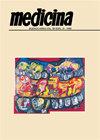[慢性神经儿科疾病中的睡眠]。
IF 0.6
4区 医学
Q3 MEDICINE, GENERAL & INTERNAL
Medicina-buenos Aires
Pub Date : 2024-09-01
引用次数: 0
摘要
众所周知,患有慢性神经系统疾病的儿童的睡眠障碍(SD)发病率会增加,这种双向的负面联系会加重他们的症状,并对儿童及其家人的生活质量产生负面影响。对于儿童神经科医生来说,识别和认识这种关联至关重要,因为治疗睡眠障碍可显著改善神经发育障碍、癫痫、原发性头痛、脑瘫和神经肌肉疾病患者的日间症状。本文章由计算机程序翻译,如有差异,请以英文原文为准。
[Sleep in chronic neuropediatric diseases].
The prevalence of sleep disorders (SD) is notoriously increased in children with chronic neurological disease, with a negative bidirectional link that aggravates their symptomatology and has a negative impact on the quality of life of the child and their families. Identifying and recognizing this association is key for the child neurologist since the treatment of SD significantly improves daytime symptomatology in neurodevelopmental disorders, epilepsy, primary headaches, cerebral palsy and neuromuscular diseases.
求助全文
通过发布文献求助,成功后即可免费获取论文全文。
去求助
来源期刊

Medicina-buenos Aires
医学-医学:内科
CiteScore
1.30
自引率
12.50%
发文量
0
审稿时长
6-12 weeks
期刊介绍:
Information not localized
 求助内容:
求助内容: 应助结果提醒方式:
应助结果提醒方式:


